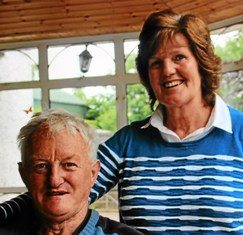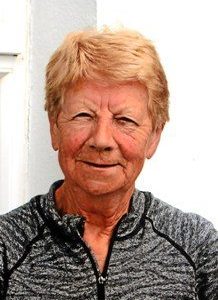James Clarke initially explains that Kilgobbin Farm was occupied by Eliza Ruttle in the 19th century and was inherited by her nephew, Charles Mills, who in turn bequeathed the property for a settlement to James Clarke, grandfather of the current James. The farm is located directly opposite Fort Union Stud and the back entrance to Adare Manor. James and his wife, Meriel, display and discuss a box of historical family letters which date back to the 19th century. They describe the right of way through the farm to Fort Union, and read from some of the letters written from the Estate Office to Charles Mills, and his replies. The contents and tone of some of the letters are quite jovial. James also discusses the water supply coming from Kilgobbin through to Fort Union and the agreement to supply the Mills home. The hive of activity which was Fort Union is remembered, with details such as the transportation of yearlings to England by train. Meriel returns to the letters, and describes their great importance in terms of the social history of Adare, and she reads from a letter sent by Charles Mills to the Rev. Canon O’Brien in 1902 in response to a letter sent to him requesting a subscription. Also read is a letter dated February 1911 sent to the Chairman and Gentlemen of Croom District Council in response to their stated intention to acquire two acres from the Mills farm on which to build cottages during the time of the Labourers Housing Act. James displays a valuation from the 1930s on the 130 acre farm. He discusses the history of the Church of Ireland School, now known as St. Nicholas’s, which was built in 1814. Lady Caroline, wife of Windham Thomas Wyndham-Quin, 4th Earl of Dunraven, established the school with 135 pupils enrolled. The numbers underwent a swift change when the local parish priest became involved, he explains, and he speaks about his own days of learning there when he was taught by Mrs Shire, the only teacher at the school. He also recalls the Church of Ireland in Adare prior to the 1960s, when it was possible to display and sell poppies openly, but once the Troubles in Northern Ireland erupted, this activity was conducted inside the church only.
The Holt family of Kildare, who are Meriel’s family, are discussed, and she explains that her maternal grandfather, Frank Gerrard, fought in World War 1, and was with the poet, Francis Ledwidge, when he was killed. He visited the Ledwidge family after the war. James explains that the Clarke family came from a farm at Ballina Killaloe, and he explains the reason why in the 1920s his father, who was also named James, with his two sisters, Josephine and Dora, came to live to live at the farm in Kilgobbin, initially in a cottage and later at the house. He discusses the active community life in which Lady Nancy Dunraven was engaged, and explains that she sat on the Board of the Church of Ireland School. James would often meet her and her husband, Richard Wyndham-Quin, 6th Earl of Dunraven, riding through the Clarke farmland to Fort Union. A final letter read by Meriel illustrates a jovial turn of phrase. It is written by Charles Mills in around 1900 in relation to Eliza Ruttle and her time at Kilgobbin Farm. Josie Cosgrave, the gatekeeper from Lantern Lodge who opened and closed the gates at the back entrance to Adare Manor in earlier days is also remembered.

James Clarke (b. 1951) and Meriel Clarke
James Clarke (b. 1951) and Meriel Clarke
€10.00 – €20.00
Additional information
| Type: | MP3 |
|---|---|
| Audio series: | The Adare Manor and Village Oral History Collection |
| Bitrate: | 128 kbps |
| Download time limit: | 48 hours |
| File size(s): | 43.7 MB |
| Number of files: | 1 |
| Product ID: | CDAD01-21 |
| Subject: | Kilgobbin Farm |
| Recorded by: | Maurice O’Keeffe – Irish Life and Lore |








